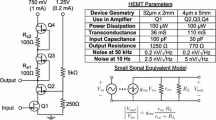Abstract
To search for dark matter candidates with masses below \(\mathcal {O}\)(MeV), the SPLENDOR (Search for Particles of Light dark mattEr with Narrow-gap semiconDuctORs) experiment is developing novel narrow-bandgap semiconductors with electronic bandgaps on the order of 1–100 meV. In order to detect the charge signal produced by scattering or absorption events, SPLENDOR has designed a two-stage cryogenic HEMT-based amplifier with an estimated charge resolution approaching the single-electron level. A low-capacitance (\(\sim \)1.6 pF) HEMT is used as a buffer stage at T = 10 mK to mitigate effects of stray capacitance at the input. The buffered signal is then amplified by a higher-capacitance (\(\sim \)200 pF) HEMT amplifier stage at T = 4 K. Importantly, the design of this amplifier makes it usable with any insulating material—allowing for rapid prototyping of a variety of novel detector materials. We present the two-stage cryogenic amplifier design, preliminary voltage noise performance, and estimated charge resolution of 7.2 electrons.



Similar content being viewed by others
References
E. Aprile et al., ( XENON Collaboration), dark matter search results from a one ton-year exposure of XENON1T. Phys. Rev. Lett. 121, 111302 (2018). https://doi.org/10.1103/PhysRevLett.121.111302
D.S. Akerib et al., ( LUX Collaboration), Results from a Search for dark matter in the complete LUX eDxposure. Phys. Rev. Lett. 118, 021303 (2017). https://doi.org/10.1103/PhysRevLett.118.021303
X. Cui et al., ( PandaX-II Collaboration), Dark matter results from 54-ton-day exposure of PandaX-II experiment. Phys. Rev. Lett. 119, 181302 (2017). https://doi.org/10.1103/PhysRevLett.119.181302
I. Alkhatib et al., ( SuperCDMS Collaboration), Light dark matter search with a high-resolution athermal phonon detector operated above ground. Phys. Rev. Lett. 127, 061801 (2021). https://doi.org/10.1103/physrevlett.127.061801
M. Battaglieri et al., US cosmic visions: new ideas in dark matter 2017: community report ( 2017). arXiv:1707.04591 [hep-ph]
P. Rosa, Y. Xu, M. Rahn, J. Souza, S. Kushwaha, L. Veiga, A. Bombardi, S. Thomas, M. Janoschek, E. Bauer, et al., Colossal magnetoresistance in a nonsymmorphic antiferromagnetic insulator, npj Quant. Mater. 5, 52 ( 2020), https://doi.org/10.1038/s41535-020-00256-8
M.M. Piva, M.C. Rahn, S.M. Thomas, B.L. Scott, P.G. Pagliuso, J.D. Thompson, L.M. Schoop, F. Ronning, P.F.S. Rosa, Robust Narrow-Gap Semiconducting Behavior in Square-Net La\(_3\)Cd\(_2\)As\(_6\). Chem. Mater. 33, 4122 (2021). https://doi.org/10.1021/acs.chemmater.1c00797
A. Phipps, A. Juillard, B. Sadoulet, B. Serfass, Y. Jin, A HEMT-based cryogenic charge amplifier with sub-100 eVee ionization resolution for massive semiconductor dark matter detectors. Nucl. Instrum. Meth. Phys. Res. A 940, 181 (2019). https://doi.org/10.1016/j.nima.2019.06.022
C. Augier, G. Baulieu, V. Belov, L. Bergé, J. Billard, G. Bres, J.-L. Bret, A. Broniatowski, M. Calvo, A. Cazes, et al., First demonstration of 30 eVee ionization energy resolution with Ricochet germanium cryogenic bolometers (2023). arXiv:2306.00166 [astro-ph.IM]
G. Fernández Moroni, J. Estrada, G. Cancelo, S. E. Holland, E. E. Paolini, and H. T. Diehl, Sub-electron readout noise in a Skipper CCD fabricated on high resistivity silicon. Exp. Astron. 34, 43–64 (2012). https://doi.org/10.1007/s10686-012-9298-x
F. Ponce, C. Stanford, S. Yellin, W. Page, C. Fink, M. Pyle, B. Sadoulet, B. Serfass, S.L. Watkins, P.L. Brink et al., Measuring the impact ionization and charge trapping probabilities in SuperCDMS HVeV phonon sensing detectors. Phys. Rev. D 101, 031101 (2020). https://doi.org/10.1103/PhysRevD.101.031101
R. Ren, C. Bathurst, Y.Y. Chang, R. Chen, C.W. Fink, Z. Hong, N.A. Kurinsky, N. Mast, N. Mishra, V. Novati et al., Design and characterization of a phonon-mediated cryogenic particle detector with an eV-scale threshold and 100 keV-scale dynamic range. Phys. Rev. D 104, 032010 (2021). https://doi.org/10.1103/PhysRevD.104.032010
R. Agnese et al. ( SuperCDMS Collaboration), First dark matter constraints from a SuperCDMS single-charge sensitive detector. Phys. Rev. Lett. 121, 051301 ( 2018), [Erratum: Phys. Rev. Lett. 122, 069901 (2019)], https://doi.org/10.1103/PhysRevLett.121.051301
A. Juillard, J. Billard, D. Chaize, J.-B. Filippini, D. Misiak, L. Vagneron, A. Cavanna, Q. Dong, Y. Jin, C. Ulysse et al., Low-noise HEMTs for coherent elastic neutrino scattering and low-mass dark matter cryogenic semiconductor detectors. J. Low Temp. Phys. 199, 798 (2019). https://doi.org/10.1007/s10909-019-02269-5
C. Cattadori, B. Gallese, A. Giachero, C. Gotti, M. Maino, and G. Pessina, A new approach to the readout of cryogenic ionization detectors: GeFRO. J. Instrum. 6 (05), P05006, https://doi.org/10.1088/1748-0221/6/05/p05006
S. L. Watkins, SPLENDAQ: A detector-agnostic data acquisition system for small-scale physics experiments ( 2023). arXiv:2310.01279 [physics.ins-det]
Y. Jin, Q. Dong, A. Cavanna, U. Gennser, L. Couraud, and C. Ulysse. In: 2014 12th IEEE International Conference on Solid-State and Integrated Circuit Technology (ICSICT) ( 2014) pp. 1–4, https://doi.org/10.1109/ICSICT.2014.7021379
Author information
Authors and Affiliations
Corresponding author
Additional information
Publisher's Note
Springer Nature remains neutral with regard to jurisdictional claims in published maps and institutional affiliations.
Rights and permissions
Springer Nature or its licensor (e.g. a society or other partner) holds exclusive rights to this article under a publishing agreement with the author(s) or other rightsholder(s); author self-archiving of the accepted manuscript version of this article is solely governed by the terms of such publishing agreement and applicable law.
About this article
Cite this article
Anczarski, J., Dubovskov, M., Fink, C.W. et al. Two-Stage Cryogenic HEMT-Based Amplifier for Low-Temperature Detectors. J Low Temp Phys 214, 256–262 (2024). https://doi.org/10.1007/s10909-023-03046-1
Received:
Accepted:
Published:
Issue Date:
DOI: https://doi.org/10.1007/s10909-023-03046-1




